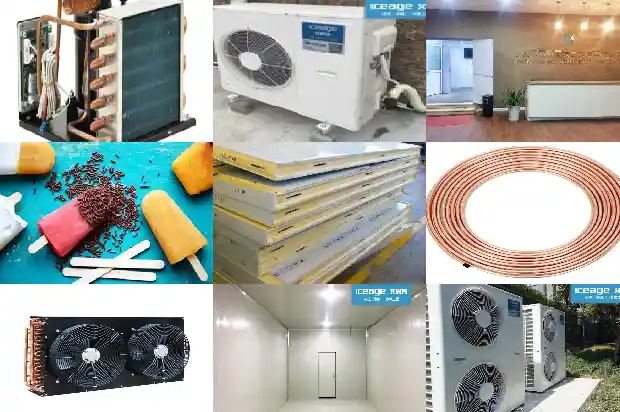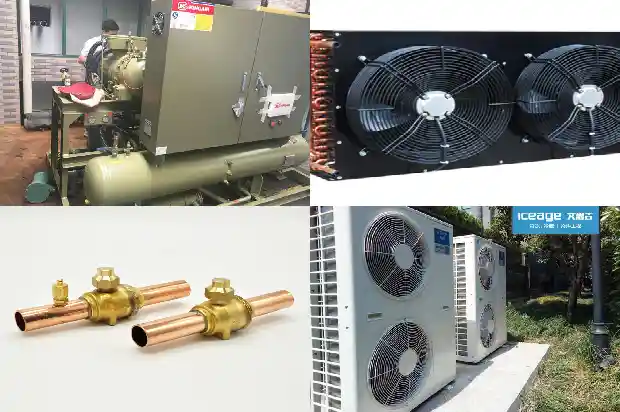Analysis of the Working Process and Principle of Hot Fluoride Defrosting for Air Coolers
2025-03-01
Air coolers have become the most commonly used evaporators in refrigeration systems because they can force air supply, improve heat exchange efficiency; are equipped with water receiving trays, are convenient for defrosting, and can adapt to various working conditions and environments; and have a relatively low cost and a low initial investment.
Although the fin spacing of air coolers has been adjusted accordingly according to different application working conditions, due to the forced air supply, the heat transfer temperature difference is increased. Therefore, the surface of air coolers in medium and low-temperature refrigeration systems frosts quickly. In large and medium-sized cold storage projects, parallel units are often used as the cold source. In a parallel refrigeration system, after the liquid supply solenoid valve of the air cooler is turned off, since other air coolers are still working, the compressor needs to continue running. The refrigerant remaining in the air cooler that has stopped working will continue to evaporate, which further intensifies the frosting on the surface of the air cooler.
The thermal conductivity of copper is 397W/(㎡·℃), the thermal conductivity of aluminum is 210W/(㎡·℃), while the thermal conductivity of frost is only 0.116~0.139W/(㎡·℃). Moreover, the frost layer will narrow the flow channel, reduce the air volume, and eventually completely block the evaporator, seriously hindering the air flow. An excessively thick frost layer deteriorates the working conditions of the refrigeration device, making it difficult to cool the cold storage room, reducing the refrigeration capacity of the compressor, and increasing its power consumption. Therefore, the air coolers in the cold storage need to be defrosted approximately every 5 to 8 hours of cumulative operation.
The commonly used defrosting methods for air coolers at present are roughly as follows:
(1) Electric Defrosting:
Electric defrosting uses the electric heating tubes arranged inside the air cooler to heat the fins to melt the frost layer. This method has a simple system and more convenient operation. However, the air cooler is equipped with about 40 to 100W of electric heating tubes per square meter of heat exchange area, resulting in extremely high power consumption. It also has a great impact on the temperature fluctuations in the cold storage, which is not energy-efficient. The power of the defrosting electric heating tubes is very high. If the quality of the heating tubes is poor or they have been used for a long time, they are likely to be burned out and may even cause a fire. Electric defrosting has serious potential safety hazards.
(2) Water Defrosting:
Water defrosting is a method of using a water pump or a water spraying device to spray water on the outer surface of the evaporator, so that the frost layer is melted and washed away by the heat of the water. Water defrosting is simple to operate and takes a short time, and it is a very effective defrosting method. In a cold storage with a very low temperature, after repeated defrosting, the water temperature is too low, which will affect the defrosting effect.
(3) Heat Medium Defrosting:
Heat medium defrosting uses the superheated refrigerant vapor with a relatively high temperature discharged from the compressor. After passing through the oil separator, it enters the evaporator. The evaporator is temporarily regarded as a condenser, and the heat released when the heat medium condenses is used to melt the frost layer on the surface of the evaporator. At the same time, the refrigerant and lubricating oil originally accumulated in the evaporator are discharged into the defrosting liquid discharge drum or the low-pressure circulation drum by means of the pressure of the heat medium or gravity. During hot gas defrosting, the load on the condenser is reduced, and the operation of the condenser can also save some electrical energy. Heat medium defrosting is the most economical way to defrost air coolers.
(1) Electric Defrosting:
Electric defrosting uses the electric heating tubes arranged inside the air cooler to heat the fins to melt the frost layer. This method has a simple system and more convenient operation. However, the air cooler is equipped with about 40 to 100W of electric heating tubes per square meter of heat exchange area, resulting in extremely high power consumption. It also has a great impact on the temperature fluctuations in the cold storage, which is not energy-efficient. The power of the defrosting electric heating tubes is very high. If the quality of the heating tubes is poor or they have been used for a long time, they are likely to be burned out and may even cause a fire. Electric defrosting has serious potential safety hazards.
(2) Water Defrosting:
Water defrosting is a method of using a water pump or a water spraying device to spray water on the outer surface of the evaporator, so that the frost layer is melted and washed away by the heat of the water. Water defrosting is simple to operate and takes a short time, and it is a very effective defrosting method. In a cold storage with a very low temperature, after repeated defrosting, the water temperature is too low, which will affect the defrosting effect.

(3) Heat Medium Defrosting:
Heat medium defrosting uses the superheated refrigerant vapor with a relatively high temperature discharged from the compressor. After passing through the oil separator, it enters the evaporator. The evaporator is temporarily regarded as a condenser, and the heat released when the heat medium condenses is used to melt the frost layer on the surface of the evaporator. At the same time, the refrigerant and lubricating oil originally accumulated in the evaporator are discharged into the defrosting liquid discharge drum or the low-pressure circulation drum by means of the pressure of the heat medium or gravity. During hot gas defrosting, the load on the condenser is reduced, and the operation of the condenser can also save some electrical energy. Heat medium defrosting is the most economical way to defrost air coolers.
At present, the barrel-pump liquid supply system is only applied in large systems because it requires the addition of many auxiliary equipment, and the increase in the size of the auxiliary equipment leads to an increase in the investment cost. In most of the medium and small cold storages in the market, taking advantage of the fact that Freon is easy to achieve automatic control, the method of using direct expansion liquid supply plus a liquid discharge drum for hot fluoride defrosting has great promotion value.
Basic Principle:
The hot Freon vapor discharged from the compressor is used to heat and defrost the air cooler. The Freon liquid after defrosting is discharged into the liquid discharge drum, and then pressurized to supply the Freon in the liquid discharge drum to the liquid supply pipe to participate in refrigeration. During defrosting, the flow direction of the liquid discharge is the same as that during the refrigeration cycle. The basic principle is as follows (see the figure):
Basic Principle:
The hot Freon vapor discharged from the compressor is used to heat and defrost the air cooler. The Freon liquid after defrosting is discharged into the liquid discharge drum, and then pressurized to supply the Freon in the liquid discharge drum to the liquid supply pipe to participate in refrigeration. During defrosting, the flow direction of the liquid discharge is the same as that during the refrigeration cycle. The basic principle is as follows (see the figure):
- Compressor Unit 2. Condenser 3. Liquid Discharge Drum 4.
Evaporator 5. Main Defrosting Solenoid Valve 6. Defrosting Solenoid Valve 7. Liquid Supply Solenoid Valve 8. Gas Return Solenoid Valve 9. Liquid Return Solenoid Valve 10. Liquid Discharge Solenoid Valve 11. Pressure Reducing Solenoid Valve 12. Pressure Increasing Solenoid Valve 13. Liquid Falling Solenoid Valve
During refrigeration: The liquid supply solenoid valve 7 and the gas return solenoid valve 8 are opened, and other solenoid valves are closed.
During defrosting: The liquid supply solenoid valve 7 and the gas return solenoid valve 8 are closed. At the same time, the main defrosting solenoid valve 5, the defrosting solenoid valve 6, the liquid return solenoid valve 9, the pressure reducing solenoid valve 11, and the liquid falling solenoid valve 13 are opened together.
At the end of defrosting: The defrosting solenoid valve 6, the liquid return solenoid valve 9, the pressure reducing solenoid valve 11, and the liquid falling solenoid valve 13 are closed simultaneously. The pressure increasing solenoid valve 12 is opened. When the pressure in the liquid discharge drum ≥ condensing pressure, the liquid discharge solenoid valve 10 is opened, and the refrigerant in the liquid discharge drum enters the liquid supply pipe to participate in refrigeration. When the liquid level in the liquid discharge drum reaches the lower limit, the main defrosting solenoid valve 5, the pressure increasing solenoid valve 12, and the liquid discharge solenoid valve 10 are closed simultaneously. The pressure reducing solenoid valve 11 automatically opens and closes automatically after reducing the pressure in the liquid discharge drum to the suction pressure.
Related Articles
- Advantages and Disadvantages of Air-cooled Multi-connected Units and Analysis of Their Components
- Cause Analysis of High Discharge Temperature and Overload Protection of Modular Units
- Analysis of the Causes and Hazards of Corrosion in the Circulating Water System
- Analysis of Common Auxiliary Components in the Refrigeration System
- Analysis of the Composition, Control and Operation Process of Cold Storage System
- Analysis of Causes for Compressor Liquid Hammer, Overheating and Pre - heating
- Analysis of Seven Reasons for Ice Formation in Computer Room Air Conditioners
- Analysis and Troubleshooting of Common Faults in Air - source Heat Pumps
- Analysis of 6 Components in Air - cooled Multi - split Systems
- Analysis of Advantages, Disadvantages and 34 Common Components of Multi - split Air Conditioners
- Common Causes and Analysis of High and Low Pressure Alarms
- Common Causes and Analysis of Compressor Thermal Protection
- Analysis of Common Faults in Compressor Overcurrent and Burnout
- Analysis of Causes for Safety Valve Leakage
- Analysis of Refrigeration Compressor Motor Faults
- Fault Analysis of Working Principle of Screw Chiller Unit
- Analysis and Treatment of Common Low-Pressure Faults in Chillers
- Analysis and Treatment of Common Low Pressure Faults in Chillers
